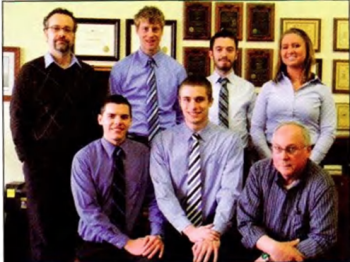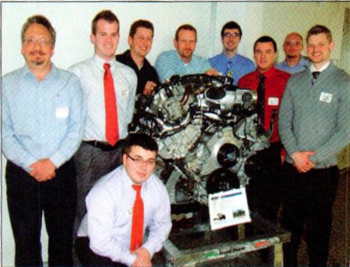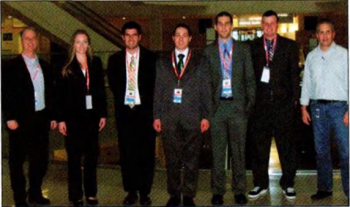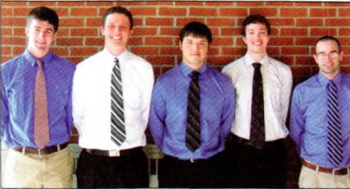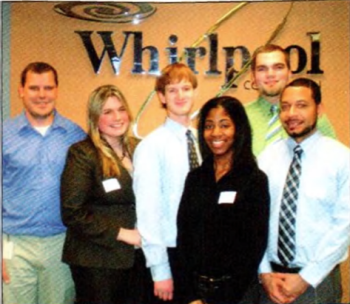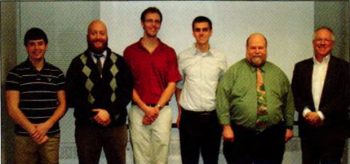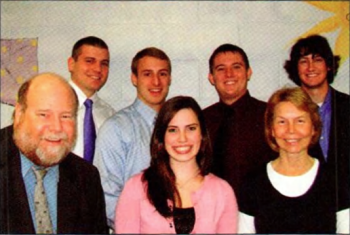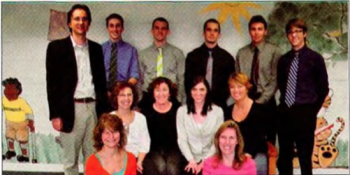Mechanical Engineering
Projects
One goal of the MSU Mechanical Engineering Program is to educate engineers who are prepared to lead, create, and innovate as their professional or graduate careers evolve. The Mechanical Engineering Design Program is the key element of the curriculum that supports this goal. There are five required design courses in the program which provide our students with eight hands-on, team-based, ‘design, test and build’ projects, and numerous opportunities to practice and refine their written, oral, poster, and video presentation skills. The Design Program in Mechanical Engineering has attracted national recognition on many occasions and helps to distinguish the ME program as one of the best in the country.
For information on becoming a project sponsor, please contact Mike Colucci.
The following are the project sponsors and projects for Spring 2012:
American Hydromech: Solid Particle Contaminant Test Stand
 Founded by Timothy A. Droste in 2007, American Hydromech has provided design and development engineering support, VAVE/DFMEA workshops, DV test, and prototype assembly and test to a number of OE, Tier I, and Tier II customers.
Founded by Timothy A. Droste in 2007, American Hydromech has provided design and development engineering support, VAVE/DFMEA workshops, DV test, and prototype assembly and test to a number of OE, Tier I, and Tier II customers.
This semester, American Hydromech of Howell, Michigan was contracted to establish a set of fundamental design rules to guide the design and development o f second-generation oil test supply modules used to execute petroleum filter multipass performance tests. Using these rules, a detailed Test Stand Design Specification (TSDS) document. 3-dimensional CAD model, and complete Bill of Materials (BOM) were created, allowing the construction of such a test facility. A key attribute includes “seamless” integration with existing dilution, injection, and data acquisition modules.
The objective of this project was to research and collate applicable government and industry standards, using them to formulate a generic Design Rule document, as well as a detailed Test Stand Design Specification for a specific oil test stand. These documents are supported by the 3-dimensional CAD model, requisite 2-D drawings, and BOM. Once these engineering documents were approved, the team constructed a Solid Particle Contaminant Oil Test Supply compliant with the aforementioned Design Rules; ISO-16889, 4548-12, and 19438 multi-pass standards; and applicable industrial safety regulations. This fully functional test stand supplies test fluid at an automatically controlled flow’ rate, compensates for temperature and pressure variation, keeps test contaminant in suspension, and provides for quick, easy routine maintenance. By following this detailed procedure, the team is confident that the final test stand will successfully test oil filters for years to come.
Robert Bosch, LLC: Fuel Return Line Service Tool for Diesel Piezoelectric Injector System
 Robert Bosch, LLC fosters an authentic culture of synergistic concurrent engineering that is responsible for innovations that are truly ‘‘invented for life.” Moreover, the potency of these innovations is reflected in the staggering 3,800 patent applications filed in the year 2010 alone, and these data provide a measure of the creative engineering workforce at Robert Bosch, LLC.Since pioneering the automotive industry’s first fuel injection system with a high-pressure electric fuel pump in 1967, Robert Bosch, LLC has been recognized as the worldwide leader in fuel injection technology and design. The introduction of diesel piezoelectric fuel injectors for high-performance diesel engines is further evidence of the company’s state-of-the-art technologies.
Robert Bosch, LLC fosters an authentic culture of synergistic concurrent engineering that is responsible for innovations that are truly ‘‘invented for life.” Moreover, the potency of these innovations is reflected in the staggering 3,800 patent applications filed in the year 2010 alone, and these data provide a measure of the creative engineering workforce at Robert Bosch, LLC.Since pioneering the automotive industry’s first fuel injection system with a high-pressure electric fuel pump in 1967, Robert Bosch, LLC has been recognized as the worldwide leader in fuel injection technology and design. The introduction of diesel piezoelectric fuel injectors for high-performance diesel engines is further evidence of the company’s state-of-the-art technologies.
This project targets the design and manufacture of a cost- effective service tool and the associated operating procedures to quickly and easily remove the fuel return lines from the diesel piezoelectric injectors used in multiple diesel engine applications in the United States. The primary goals o f the tool are to reduce service technician down-time and mitigate unnecessary warranty costs due to broken injector connectors, thereby creating an innovation worthy of being “invented for life.”
Founder Robert Bosch stated. “I would rather lose money than trust. The integrity of my promises, the belief in the value of my products and of my word of honor have always had a higher priority.” The company’s staunch commitment to providing customers with the support they need is clearly evidenced today. Engineers were quick to initiate a product development project when service technicians informed them that they were not able to efficiently remove the fuel return lines that connect to the diesel piezoelectric injectors, instead breaking the connecter and risking the integrity of the fuel injectors to save time.
Chrysler LLC: Front Seat Adjustable Armrest
 Robert Bosch, LLC: Fuel Return Line Service Tool for Diesel Piezoelectric Injector SystemSince 1925, Chrysler has maintained its place as one of the leading automobile manufacturers in the world. Founder Walter P. Chrysler once said, “the real secret of success is enthusiasm,” an idea which still resonates throughout the corporation. Even through the rough economy of the past several years they continue to forge on. Updating their vehicle line and staying true to their customer base has granted them success over their long history.
Robert Bosch, LLC: Fuel Return Line Service Tool for Diesel Piezoelectric Injector SystemSince 1925, Chrysler has maintained its place as one of the leading automobile manufacturers in the world. Founder Walter P. Chrysler once said, “the real secret of success is enthusiasm,” an idea which still resonates throughout the corporation. Even through the rough economy of the past several years they continue to forge on. Updating their vehicle line and staying true to their customer base has granted them success over their long history.
The Chrysler Seat Team has unveiled numerous innovative designs to maintain and exceed customer satisfaction. These innovations are presented in their line of minivans and include the Stow ’n Go storage feature and Swivel ’n Go swiveling second row seats. Offering class leading seat configurations gives Chrysler an edge over their competitors.
Chrysler is interested in offering seats with an adjustable armrest in automobiles that cannot use the center console for that function. The primary vehicles that would feature this armrest are their line o f minivans. Current armrests are limited to only one engaged position, which lacks the personal fit needed in a comfortable, luxurious automobile. The adjustable armrest design aims at being height adjustable as well as angle adjustable to accommodate customers across the spectrum.
The student team is assisting Chrysler by creating a concept design that meets structural requirements, is lightweight, and user- friendly. Using motors to power the armrest’s adjustability allows infinite fine-tuning in both the vertical and angular directions. Users of all sizes will enjoy their new adjustable armrest adaptable just for them.
Ford Motor Company: Direct Connection of Fuel Vapor Hose
 Ford Motor Company has been one of the leading companies in the automobile industry since its founding by Henry Ford in 1903. Henry Ford is most famous for his successful implementation of the assembly line in the company’s manufacturing facilities. Today, Ford Motor Company is headquartered in nearby Dearborn, Michigan, with a variety of quality vehicles on the market.
Ford Motor Company has been one of the leading companies in the automobile industry since its founding by Henry Ford in 1903. Henry Ford is most famous for his successful implementation of the assembly line in the company’s manufacturing facilities. Today, Ford Motor Company is headquartered in nearby Dearborn, Michigan, with a variety of quality vehicles on the market.
For our capstone design project, our team worked on a material cost reduction project within this carbon canister system. This project involved the potential elimination of the quick connector component at the hose connection port of the carbon canister. Various design alternatives were researched and evaluated based on specifications such as cost, ease of assembly, and potential failure modes. The most effective solution was then selected and pursued
Our project involved working with the fuel system of a variety of Ford and Lincoln models. Per EPA requirements, fuel vapor must not escape into the atmosphere. For this reason, automobiles contain a carbon canister system to collect these harmful vapors. Currently, this system is connected to the fuel tank via hoses which attach with a costly quick connector device. Although a single quick connector may seem like an inexpensive component, the removal of such a part on a mass production scale has the potential to save Ford Motor Company a significant amount of money.
Louis Padnos Iron & Metal Company: Inductive Proximity Sensor
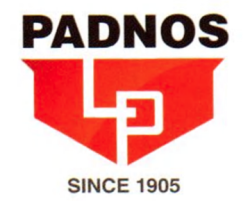 Louis Padnos Iron & Metal has sought to safely and efficiently recycle metals and other materials for over a century. They strive to use the newest and most effective technology in breaking down and processing these materials. The objective of the company is to provide comprehensive sorting of the scrap in order to
Louis Padnos Iron & Metal has sought to safely and efficiently recycle metals and other materials for over a century. They strive to use the newest and most effective technology in breaking down and processing these materials. The objective of the company is to provide comprehensive sorting of the scrap in order to
reduce waste.
Padnos receives a broad array of unsorted materials. In order for these constituents to be processed, they must be sorted by type. After a piece of metal is identified it needs to be separated from the rest of the scrap. One of their primary methods of sorting is an array of UHMW Polyethylene displacers. When these displacers are fired they force the selected material out of its path and into an appropriate container.
While this system is very effective, at the current state the displacers are achieving an average of 1 million cycles before failure. The parts in place have been known to achieve as many as 10 million cycles. Production of these displacers needs to be optimized to increase the overall life of the units.
By focusing on increasing the fatigue resistance of the individual parts of the system as well improving their orientation and the fabrication process, system life will increase. The optimization of the displacers will save Padnos both time and money.
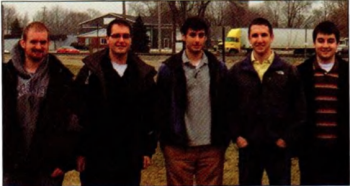
Team Members: Peter Bently, Ryan Lureau, Jonathan Lusczakoski, Christopher Matthes, Benjamin Wilburn
Whirlpool Corporation: Adjustable Ice Level Control for an Ice Maker
Whirlpool Corporation is a global leader in home appliances marketed in almost every country around the world. It manufactures appliances across all major categories, including fabric care, cooking, refrigeration, dishwashers, countertop appliances, garage organization, and water filtration. Whirlpool instills innovation as a core expertise within its company, thus promoting new ideas to deliver endless quality to its consumers. Whirlpool’s passion for excellence has prompted it to provide a solution to today’s primary problem in refrigeration systems equipped with automatic ice dispensers.
 Ice dispensing systems function to provide the consumer with ice at any given time. Therefore, it maintains the maximum capacity of its container by replenishing any used ice. This aspect of an ice-dispensing system results in unused ice, which absorbs food odors over time from the air that circulates throughout the refrigerator. This results in ice with undesirable surface finish and taste.
Ice dispensing systems function to provide the consumer with ice at any given time. Therefore, it maintains the maximum capacity of its container by replenishing any used ice. This aspect of an ice-dispensing system results in unused ice, which absorbs food odors over time from the air that circulates throughout the refrigerator. This results in ice with undesirable surface finish and taste.
Whirlpool has tasked the team with providing a solution to this universal problem in automatic ice-dispensing systems. The goal is to help reduce the amount of unused ice and retain ice with a good taste and surface finish. This was accomplished by providing Whirlpool with unique solutions that can be implemented in existing refrigeration units. The team supplied Whirlpool with new ideas, CAD models, and a prototype incorporating leading-edge, infrared technology that embodied their passion for innovation.
A solution was delivered that would ultimately allow the consumer to control the amount of ice collected in the container, thus improving the quality of ice.
Whirlpool Corporation: Solar Powered Refrigerator
 Established in 1911 in Benton Harbor, Michigan, Whirlpool Corporation has been designing and manufacturing home appliances for over 100 years. Since then Whirlpool has managed to acquire and develop a wide variety ofbrands such as Maytag, KitchenAid. Jenn-Air, and Amana to meet the demands of today’s consumer. As a multi-national company and “the largest home appliance manufacturer in the world,” Whirlpool currently employs more than 70,000 people and generates annual revenues of over S18 billon. Engineers at Whirlpool are constantly creating new products to meet the needs of consumers as well as striving to increase the efficiency, performance, and ease of use of the plethora of consumer goods which they already produce including home appliances, HVAC systems, and a wide array of kitchen products. The Whirlpool – Gold appliance line, including the Gold 25.5 Cu. ft french door refrigerator used in this project, is one of the best-selling product lines on the U.S. market.
Established in 1911 in Benton Harbor, Michigan, Whirlpool Corporation has been designing and manufacturing home appliances for over 100 years. Since then Whirlpool has managed to acquire and develop a wide variety ofbrands such as Maytag, KitchenAid. Jenn-Air, and Amana to meet the demands of today’s consumer. As a multi-national company and “the largest home appliance manufacturer in the world,” Whirlpool currently employs more than 70,000 people and generates annual revenues of over S18 billon. Engineers at Whirlpool are constantly creating new products to meet the needs of consumers as well as striving to increase the efficiency, performance, and ease of use of the plethora of consumer goods which they already produce including home appliances, HVAC systems, and a wide array of kitchen products. The Whirlpool – Gold appliance line, including the Gold 25.5 Cu. ft french door refrigerator used in this project, is one of the best-selling product lines on the U.S. market.
Currently, Whirlpool is investigating the use of alternative energy systems in its home appliances. In the future, the implementation of these systems will not only benefit the environment but also consumers by reducing total household energy costs. These technologies will also prove beneficial to those living “off the grid” either by choice or in remote areas where access to municipal power is not possible. The choice of a refrigerator being used in this project was not by chance. The energy consumption o f an efficient refrigerator while running may be equivalent to that of a 60 or 80 Watt light bulb; however over time, this adds up to 7% of the total power used by an average household. This project, as well as continuing research on home energy production and consumption, will enable Whirlpool to incorporate alternative energies into future product designs and maintain its status as the world’s leading appliance manufacturer.
Whirlpool Corporation: Variable Temperature Water Dispensing System
 Whirlpool Corporation is a major manufacturer of home appliances. It was founded in 1898 and is based in Benton Harbor, Michigan. Its main product lines
Whirlpool Corporation is a major manufacturer of home appliances. It was founded in 1898 and is based in Benton Harbor, Michigan. Its main product lines
include laundry appliances, refrigerators, cooking appliances, dishwashers, mixers, and other small household appliances. Whirlpool’s focus is to create value and loyal customers and to be
inside every home and in every room.
Following this vision, Whirlpool has determined that consumers want the ability to control the temperature of water dispensed from their refrigerators. Refrigerators currently available in the market only dispense cold water, so the main project task is to design a temperature regulating system. Desired temperatures vary by region; for this project, a range of water temperatures from cold to ambient (42°F -70°F) is required to satisfy the needs of European and Latin American consumers. Ideally, the proposed system could be used as a base model for a system that provides a full temperature range, from boiling to cold, to be used in the North American market.
Currently, water is gravity-fed and filtered in a door- mounted reservoir where it is kept at refrigerator temperature. Methods including flash heating, mixing streams of different temperatures, and other methods, were researched to come up with the best solution meeting the space, energy efficiency, and cost standards required by Whirlpool. A variable temperature system has been designed for the European gravity-fed, refrigeration market. The same concept can be adapted for a force-fed system that would be plumbed from a w’ater line.
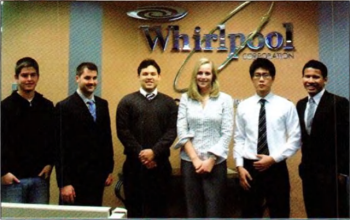
Team Members: Nilutpol Basumatari, Dustin Colthorp, FernandoVasquez Dheming, Kyoungho Kim, Brady Thom
Nexteer Automotive: Optimization of Torsion-Bar Component Desig
 The goal of this project is to optimize the Torsion-Bar component of the electric power steering (EPS) systems manufactured by Nexteer Automotive. The redesign of the component reduces the overall cost of the component by improving manufacturability, ease of assembly, and reliability. This was achieved by addressing critical factors of the torsion bar including mechanical loading, fatigue life, material composition, connection method, and total assembly package size, while maintaining the necessary performance standards.
The goal of this project is to optimize the Torsion-Bar component of the electric power steering (EPS) systems manufactured by Nexteer Automotive. The redesign of the component reduces the overall cost of the component by improving manufacturability, ease of assembly, and reliability. This was achieved by addressing critical factors of the torsion bar including mechanical loading, fatigue life, material composition, connection method, and total assembly package size, while maintaining the necessary performance standards.
Several design alternatives were investigated to increase the effectiveness of the torsion bar and retain its functional properties. The torsion bar is the element o f the EPS system that allows angular misalignment between the steering wheel and the assist system. A sensor measures this misalignment and actuates an electric motor, supplying power assistance to the driver turning the road wheels of the vehicle. The reliable angle of twist, material integrity, and manufacturability of the part were immediately identified as key characteristics of the torsion bar.
To maintain a reliable angle of twist while reducing part cost, both the end connections o f the torsion bar and the torsion bar material could be altered. Two of the design alternatives included a torsion bar with square or octagonal end geometries. Prototype torsion bars were also created from steels of different carbon contents under current specifications to investigate the effect of changing the composition. Finally, new material hardening methods were researched at length to inspect the feasibility of using a less expensive material and hardening it to avoid costly manufacturing errors, namely galling.
Rennco LLC: Lift Seal-Pouch Seal Validation
 Rennco LLC is a company established in 1969, which specializes in sealing systems for various bag applications. Rennco entered the market by introducing a new, simple, cost-effective sealing
Rennco LLC is a company established in 1969, which specializes in sealing systems for various bag applications. Rennco entered the market by introducing a new, simple, cost-effective sealing
system for various products packaged in polyethylene, polyolefin, and PVC films. Rennco’s trademark is its low-maintenance, continuously
heated and coated sealing bar, which provides sealing without the smoke
or odor associated with melting plastic. Currently, Rennco manufactures
custom packing machinery and systems. Its customers include domestic
and international food service disposable products manufacturers. Rennco’s machinery line ranges from semi-automatic bagging systems to fully-automatic bagging machines.
Currently, one of Rennco’s best-selling products is its Lift Seal Heat Sealer LSI8. This device is a medical application, as it seals sterilization-ready bags for hospitals. It makes a half-inch-wide seal with approximately 30PSI of sealing pressure for a duration of 2.5 seconds. This product has been unchanged for 20 years.
The project goal is to sense and record temperature, pressure, and time of sealing. If a seal’s captured data does not meet the specified constraints, a visual alarm must light up, indicating that sealing was not successful. Adding these features to the product would put Rennco’s lift seal heat sealers in the market with much more expensive devices that have similar capabilities, at a much lower price. Currently, the product has adjustable temperature settings, and a temperature sensor.
Research was conducted on controllers and pressure sensors. Programming the controller was a crucial point, and knowledge in programming language was required. It was also important to have the data recorded in a user-friendly program with the end consumer being hospital faculty.
A Shell Oil Company Humanitarian Project: The Appropriate Technology Collaborative: Solar Coffee Dryer
 The Appropriate Technology Collaborative was founded with the goal of creating sustainable technologies to promote economic growth and improve the quality of life for low income people around the world. It works with local groups and nonprofit organizations to develop culturally sensitive, environmentally responsible, and locally repairable solutions to everyday issues. Previous ATC projects include Bamboo Reinforced Concrete, BioFuels, Solar/LED Lighting, and Solar Refrigeration.
The Appropriate Technology Collaborative was founded with the goal of creating sustainable technologies to promote economic growth and improve the quality of life for low income people around the world. It works with local groups and nonprofit organizations to develop culturally sensitive, environmentally responsible, and locally repairable solutions to everyday issues. Previous ATC projects include Bamboo Reinforced Concrete, BioFuels, Solar/LED Lighting, and Solar Refrigeration.
Farmers in rural Guatemala grow, harvest, and dry coffee beans that are sold to be roasted. The drying o f the beans is directly related to the quality of the coffee produced and its selling price. Conditions in the mountainous region surrounding Lake Atitlan are good for growing coffee; however, the drying process used is less than optimal. Generally, beans are spread out on a taipaulin or concrete slab to be dried by the sun.
The goal of the design team is to increase the effectiveness of the coffee drying process by developing a solar coffee dryer. The dryer is designed to be constructed using materials and methods available in country that minimize cost and environmental impact. Solar processes to be investigated are passive, active, water-based, and thermal storage.
The final design utilizes a solar collector in combination with a thermal mass storage system. The thermal mass storage system is a compost pile that can also create heat or crushed rock that can store heat to be used in the drying process. The goal is to introduce several heat sources that can be combined to decrease the amount of time required to dry the coffee and increase the quality o f the coffee.
A Shell Oil Company Humanitarian Project: Heartwood School: Interactive Garden Additions
 Heartwood School is located in Mason, Michigan and serves students in the Ingham Intermediate School District with moderate to severe cognitive impairments, severe multiple impairments, autism spectrum disorders, and traumatic brain injuries. The ages of Heartwood students range widely, between 3 and 26 years old.
Heartwood School is located in Mason, Michigan and serves students in the Ingham Intermediate School District with moderate to severe cognitive impairments, severe multiple impairments, autism spectrum disorders, and traumatic brain injuries. The ages of Heartwood students range widely, between 3 and 26 years old.
Teachers and faculty of the school work hard to support the students and
enable them to reach their full potential.
The objective of the project was to provide an opportunity to engage the students mentally while simultaneously improving their physical strength. This objective was achieved through the addition of interactive structures to the existing children’s garden at Heartwood School. These structures incorporate multiple senses and stimulate students both mentally and physically while providing an enjoyable experience for all visitors.
Heartwood School uses the Mobility Opportunities Via Education/ Experience (MOVE) curriculum, which is designed to help students improve their ability to sit, stand, walk, and transition from one position to another. The project developed by the Heartwood School Student Design Team fits well with the MOVE curriculum because of the focus on interactivity and physical strengthening.
The interactive structures include an archway that incorporates a variety of senses using moving blocks and a flagpole with a variety of visually stimulating attachments. The archway encompasses a gravel path through the garden and has interactive elements on both sides of the supports. One element is an abacus with sliding wooden disks. The freestanding flagpole is operated by a simple mechanism that allows the students to raise and lower the flag or any other accessory with ease.
A Shell Oil Company Humanitarian Project: Heartwood School: MOVE Delivery Car
 Heartwood School serves students in Ingham County who are eligible to receive sen ices under the categories of moderate and severe cognitive impairments, severe multiple impairments, autism spectrum disorders, and traumatic brain injuries. Heartwood staff works with local school districts and families to provide center-based programs and services to students.
Heartwood School serves students in Ingham County who are eligible to receive sen ices under the categories of moderate and severe cognitive impairments, severe multiple impairments, autism spectrum disorders, and traumatic brain injuries. Heartwood staff works with local school districts and families to provide center-based programs and services to students.
In an effort to increase functionality and motor abilities, physical activity is integrated into the students’ daily activities. Heartwood School utilizes the MOVE curriculum to achieve this. The MOVE Curriculum is a top-down, activity-based curriculum designed to teach students the basic, functional motor skills of sitting, standing, and walking needed for life within the home and community environments. The curriculum combines natural body mechanics with an instructional process to help students acquire increasing motoric independence.
The project tasks include incorporating the MOVE curriculum into a cart that is used for daily activities. The cart will be used to improve motor abilities while completing daily activities such as transporting food from room to room, delivering mail, and returning lunch trays. The design will engage students in physical processes that will contribute to the movement of the cart.
Currently, Heartwood School is using a cart that was a previous Michigan State University capstone project. The standard cart attaches to a student’s mobility equipment and is used on a daily basis. However, it does not include any physically engaging features.
A Shell Oil Company Humanitarian Project: Lansing School K-8 STEM Academy: Year-Round Vericomposting Bin
 Founded and headquartered in Benton Harbor, Michigan, Whirlpool Corporation is the world’s largest major manufacturer, with 70 manufacturing and technology research centers throughout the world. For many years, Whirlpool has created high-quality washing machines that are both reliable and innovative. Currently, standard washing machines include a drain pump while higher efficiency models also feature a recirculation pump. This additional pump recirculates detergent-rich water from the base of the tub back onto the clothes, thus conserving water and saving energy while providing better cleaning. Although this system conserves water for the consumer, the overall unit cost is higher due to two separate pump motors. Whirlpool is, therefore, interested in designing a pumping system which combines the drain and recirculation pumps. The new system must be able to function and maintain the same standards of the individual pump systems while only using one motor.
Founded and headquartered in Benton Harbor, Michigan, Whirlpool Corporation is the world’s largest major manufacturer, with 70 manufacturing and technology research centers throughout the world. For many years, Whirlpool has created high-quality washing machines that are both reliable and innovative. Currently, standard washing machines include a drain pump while higher efficiency models also feature a recirculation pump. This additional pump recirculates detergent-rich water from the base of the tub back onto the clothes, thus conserving water and saving energy while providing better cleaning. Although this system conserves water for the consumer, the overall unit cost is higher due to two separate pump motors. Whirlpool is, therefore, interested in designing a pumping system which combines the drain and recirculation pumps. The new system must be able to function and maintain the same standards of the individual pump systems while only using one motor.
The MSU team will create new concepts for this combined system that meet the specified Whirlpool requirements. A Pugh Matrix will be utilized to determine the most inventive and effective design. A prototype of the optimal design will be built, tested, and refined, then delivered to Whirlpool for further evaluation.
Peckham: Recyclable Fabric Defect Marking Methods
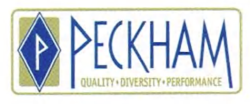 Heartwood School serves students in Ingham County who are eligible to receive sen ices under the categories of moderate and severe cognitive impairments, severe multiple impairments, autism spectrum disorders, and traumatic brain injuries. Heartwood staff works with local school districts and families to providecenter-based programs and services to students.
Heartwood School serves students in Ingham County who are eligible to receive sen ices under the categories of moderate and severe cognitive impairments, severe multiple impairments, autism spectrum disorders, and traumatic brain injuries. Heartwood staff works with local school districts and families to providecenter-based programs and services to students.
In an effort to increase functionality and motor abilities, physical activity is integrated into the students’ daily activities. Heartwood School utilizes the MOVE curriculum to achieve this. The MOVE Curriculum is a top-down, activity-based curriculum designed to teach students the basic, functional motor skills of sitting, standing, and walking needed for life within the home and community environments. The curriculum combines natural body mechanics with an instructional process to help students acquire increasing motoric independence.
The project tasks include incorporating the MOVE curriculum into a cart that is used for daily activities. The cart will be used to improve motor abilities while completing daily activities such as transporting food from room to room, delivering mail, and returning lunch trays. The design will engage students in physical processes that will contribute to the movement of the cart.
Currently, Heartwood School is using a cart that was a previous Michigan State University capstone project. The standard cart attaches to a student’s mobility equipment and is used on a daily basis. However, it does not include any physically engaging features.
